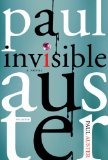Summary | Excerpt | Reviews | Beyond the Book | Read-Alikes | Genres & Themes | Author Bio

Critics' Opinion:
Readers' Opinion:
First Published:
Oct 2009, 320 pages
Paperback:
Jun 2010, 320 pages
 Book Reviewed by:
Book Reviewed by:
Amy Reading
Buy This Book
This article relates to Invisible
Paul Auster frequently employs two particular literary techniques which, when combined, turn his novels into multi-layered stories with internal echoes and reverberations.
The first is a frame narrative, in which the main plot is a story, usually in the form of a manuscript, which is discovered and introduced by someone else. This device paradoxically helps establish the reality of Auster's world at the same time that it highlights the book's flagrant fictionality as mere words on a page. On the one hand, the embedded story's status as a text prevents the reader from getting fully immersed in it. On the other hand, the context that is built around the embedded story becomes a kind of self-referential world. It is the resonance between the textual layers that begins to feel real to Auster's readers. In Invisible, we get to experience Jim Freeman's perception of Adam Walker, and this invests Walker with a flesh-and-blood dimensionality that a straightforward autobiography has a hard time conveying.
The second technique is ekphrasis*, which is when a work of art depicts an artwork from another genre, such as a painting of a sculpture. In literature, it refers to an extended description of a visual object, and perhaps the most famous example is John Keats' "Ode on a Grecian Urn." For Auster, the most common object of his ekphrasic reveries is cinema, and he frequently pauses the forward thrust of his novels in order to linger on a film frame by frame, describing its plot but also its camera angles and changes in mood. It pays to sit up straight and pay extra attention to a book at such moments, because authors use ekphrasis to clue readers in to larger themes. What he chooses to describe, how he describes it, what role the object plays in the larger story - these are highly selected and crafted details that reveal the author's literary values. Thus a film that Adam Walker sees in which a dead woman comes back to life has meaning in Invisible not only because of how emotionally moved Walker is by the film's climax, but also because the film's aesthetic style tells us something crucial about Auster's own.
*from the Greek verb ekphrazein, to recount or describe.
Filed under Books and Authors
![]() This "beyond the book article" relates to Invisible. It originally ran in November 2009 and has been updated for the
June 2010 paperback edition.
Go to magazine.
This "beyond the book article" relates to Invisible. It originally ran in November 2009 and has been updated for the
June 2010 paperback edition.
Go to magazine.





The Flower Sisters
by Michelle Collins Anderson
From the new Fannie Flagg of the Ozarks, a richly-woven story of family, forgiveness, and reinvention.

The House on Biscayne Bay
by Chanel Cleeton
As death stalks a gothic mansion in Miami, the lives of two women intertwine as the past and present collide.

The Funeral Cryer by Wenyan Lu
Debut novelist Wenyan Lu brings us this witty yet profound story about one woman's midlife reawakening in contemporary rural China.
Your guide toexceptional books
BookBrowse seeks out and recommends the best in contemporary fiction and nonfiction—books that not only engage and entertain but also deepen our understanding of ourselves and the world around us.